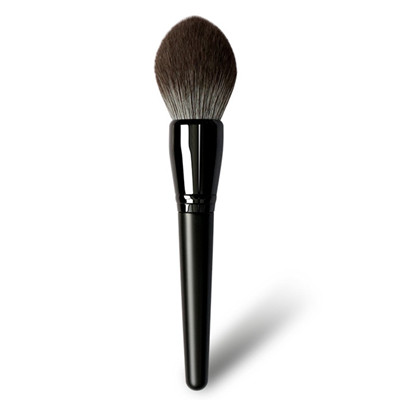The following is a detailed description of the common wooden handle materials of makeup brushes, as well as their characteristics and pro/cons in different level makeup brushes,for customers’ reference during OEM makeup brushes.
►Common wooden types
1. Solid wood
| Type | Features | Applications |
| Birch |
- Density 0.55-0.75g/cm³, straight and fine texture - Easy to dye, low cost |
Normal makeup brushes, mass-produced |
| Ebony |
- Density 1.2-1.3g/cm³, high hardness (Janka value 3200) - Natural dark black, no need dyeing required |
High-end luxury brushes, collection-level products |
| Cherry |
- Density 0.6g/cm³, warm red color and deepens over time - Poor crack resistance (need coating protection) |
Retro-style brushes, niche designer brands |
| Walnut |
- Density 0.65g/cm³, chocolate-colored stripes - Medium to high deformation resistance (water content needs to be controlled at 8%-10%) |
Mid-to-high-end professional brushes |
| Bamboo |
- Density 0.7-0.9g/cm³, naturally antibacterial - Longitudinal fiber structure, high bending strength |
Environmentally friendly brushes, portable travel makeup brushes |
2.Composite material
| Type | Features | Applications |
| Wood Plastic Composites |
- Wood powder + PE/PP substrate (wood accounts for 40%-60%) - Good moisture resistance, can be injection molded into complex shapes |
Low-cost moisture-proof, outdoor makeup brushes |
| Multilayer Glued Laminated Timber |
- Cross-linked thin wood slices glued together - Cracking resistance increased by 3 times, but the texture is more industrial |
Large brush handle (for example body brushes) |
| Resin impregnated wood |
- Vacuum impregnation of wood with epoxy resin - Hardness increased by 50%, mildew and antibacterial (cost ↑30%) |
High-end waterproof brushes and medical beauty tools |
►Key Performances Comparison
| Index | Best material | Worst Material | Key data reference |
| Moisture resistance | Resin impregnated wood (water absorption <3%) | Cherry wood (water absorption 12%) | The equilibrium moisture content should be controlled at 8%-12% |
| Wear resistance | Ebony (Mohs hardness 5.5) | Birch (Mohs hardness 4.0) | Surface coating can increase the hardness by 1-2 levels |
| Lightweight | Bamboo (density 0.7g/cm³) | Ebony(Density 1.3g/cm³) | Hollow structure can reduce weight by 40% |
| Cost | Birch | Ebony | CNC engraving costs about $1/minute |
| Eco friendly | FSC certified bamboo (biodegradable) | Wood plastic material (including PE/PP) | The carbon footprint of a pure solid wood handle is 60% lower than that of plastic |
►Processing
1. Wood pretreatment
- - Drying: Kiln drying to moisture content of 8%-12% (natural drying takes 6-12 months, kiln drying shortens to 2 weeks)
- - Stabilization: Resin curing (to prevent cracking) or wax impregnation (to improve gloss)
2. Shaping
- Turning and engraving: CNC machine processing accuracy ±0.1mm, suitable for complex patterns (such as spiral patterns, relief)
- Jointing technology: Finger joint mortise and tenon structure (strength is 20% higher than gluing) or veneer (0.5mm rare wood veneer + base material)
3. Surface treatment
| Type | Effect | Cost increase | Durability |
| Water-based paint spraying | Matte/glossy, environmentally friendly and odorless | +$0.4-0.7/pcs | Scratch resistance (500 times steel wool test) |
| Wood wax oil penetration | Preserve the wood feel and highlight texture | +$0.7-1.4/pcs | Need reapply every 6 months |
| UV Curing Coating | High hardness (3H pencil hardness), chemical resistance | +$1.4-2.1/pcs | Alcohol wiping resistance > 1000 times |
►Some pseudo-concepts
1. "Hundred-year-old wood"
- The truth: The stability of wood has no direct relationship with the age of the tree. The moisture content of 100-year-old wood may be higher, and easy to deform.
2. "Pure hand-carved"
- The truth: 99% of mass-produced wooden handles are CNC-carved, and only the final polishing is done by hand (the labor time accounts for <5%).
3. "Nano-mildewproof"
- The truth: The type of mildewproof agent is not specified (such as toxic TCMTB), to comply, should use IPBC (cost is 3 times higher).
►Selection suggestions
1. High-end luxury makeup brushes
- - Material: ebony/rosewood + lacquer
- -Process: hand-painted more than 7 layers, inlaid with mother-of-pearl/gold foil
- - Material: FSC certified birch + UV coating
- - Process: hollow design to reduece weight, laser engraved LOGO
- - Material: bamboo + wood wax oil
- - process: Keep the natural shape of bamboo joints, no glue mortise and tenon joints
►Trends
- Lightweight: Ultra-thin bamboo lamination technology (thickness 0.5mm, strength comparable to solid wood)
- Intelligent Fusion: Capacitive touch chip embedded in wooden handle (function achieved through differences in wood conductivity)
- Cultural Empowerment: Traditional wood carving craft + modern design
►Precautions
- - Prevention of cracking: The recommended moisture content is ≤10% in areas south of 35°N, and ≤12% in areas north of 35°N
- - Environmental certification: FSC/PEFC certificates are required for Europe and the United States markets
- - Allergy risk: Some wood contains natural volatiles (such as ebony sawdust can cause respiratory irritation)
When choosing a wooden handle makeup brush, customers need to balance the texture, cost, and use environment, and be wary of "low-price solid wood" (mostly veneer composite materials). It is recommended to ask the makeup brush manufacturers to provide wood traceability certification and moisture content test report to ensure quality stability.







